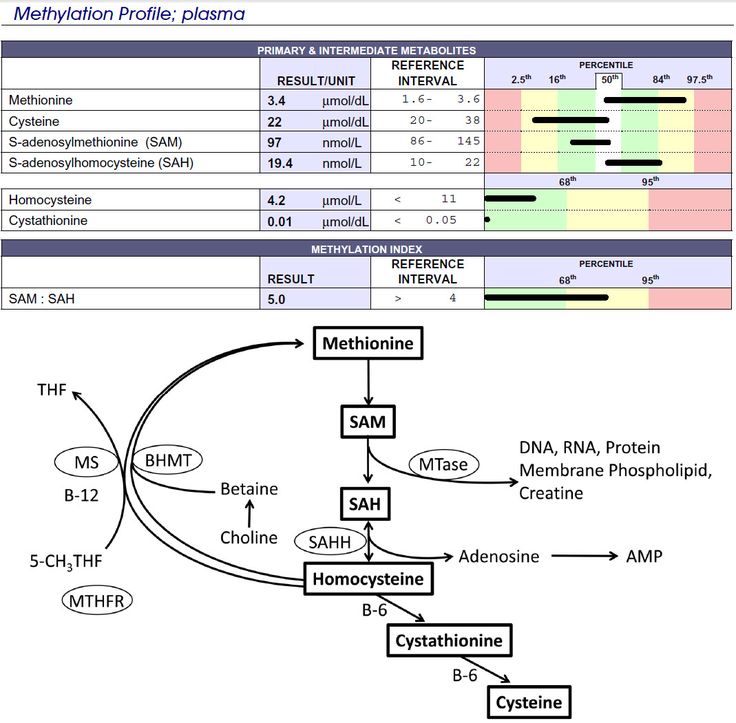
Undermethylation in Autism — What the Plasma Methylation Panel and SAM:SAH Ratio Reveal
Methylation is a core biochemical process that governs mood, energy, and detoxification. In autism, undermethylation is among the most consistent findings — confirmed in clinical studies and in Dr. William Walsh’s analysis showing that nearly 90 percent of individuals on the spectrum are undermethylated. Unlike popular MTHFR folate autism explanations, the true picture emerges through laboratory analysis of whole blood histamine and the plasma methylation panel, which measures methionine, SAM, SAH, and homocysteine. These values show how well the body transfers methyl groups, detoxifies oxidants, and protects mitochondrial energy.
The Role of Whole Blood Histamine in Autism
Whole blood histamine is a reliable screening marker for methylation capacity. Elevated histamine usually signals undermethylation autism — slower breakdown of histamine due to low methyl-group availability. Low histamine suggests overmethylation. In practice, histamine gives a quick view of neurotransmitter balance and guides interpretation of the more detailed plasma methylation panel autism results.
Understanding the Plasma Methylation Panel
This panel maps each step of the methylation cycle — showing whether nutrients and enzymes can move methyl groups efficiently to sustain energy and antioxidant defenses. The key markers include methionine, SAM, SAH, and homocysteine, and the ratio of SAM to SAH (SAM:SAH ratio) provides a single metric for overall methylation potential.
Methionine
Methionine is the entry point for methylation and a precursor to SAM. Low methionine may reflect poor protein absorption or high oxidative demand pulling sulfur toward glutathione production. High methionine with low SAM suggests energy or enzyme limitations within mitochondria.
S-Adenosylmethionine (SAM)
SAM is the body’s main methyl donor. It supports serotonin, dopamine, and phospholipid production. A low SAM or low SAM SAH ratio autism pattern points to fatigue, low mood, and sluggish detoxification. Normal methionine with low SAM often indicates impaired ATP generation or magnesium and B12 deficiency — highlighting the link between methylation and mitochondrial energy.
S-Adenosylhomocysteine (SAH)
SAH forms after SAM donates a methyl group. When SAH accumulates, it blocks further methylation, slowing neurotransmitter and creatine synthesis. Elevated SAH is common in undermethylation autism and may reflect oxidative stress, zinc deficiency, or reduced kidney filtration. The SAM:SAH ratio below 6 is a hallmark of impaired methylation efficiency.
Homocysteine
Homocysteine sits at the branch between methylation and detoxification. High levels suggest poor sulfur conversion or low vitamin B6 and N-acetylcysteine (NAC). Low homocysteine can mean excessive diversion into glutathione during oxidative stress. Balanced levels show that methylation and transsulfuration are working in sync to protect mitochondria.
Why Folate Is Not Always the Answer
The MTHFR folate autism narrative often leads to high-dose methylfolate use, but in undermethylated individuals this can backfire. Excess folate accelerates serotonin and dopamine reuptake, lowering their activity and worsening emotional symptoms. Dr. Walsh’s findings show that most autistic patients need support for methyl transfer and antioxidant balance — not extra folate. Improving SAM production, lowering SAH, and enhancing zinc-dependent enzymes restores a healthier equilibrium.
Clinical Interpretation for Physicians
The plasma methylation panel autism offers a roadmap rather than a supplement list. Patterns help the clinician locate bottlenecks — whether energy limitation (low SAM), oxidative back-pressure (high SAH), or sulfur imbalance (abnormal homocysteine). Integrating these findings with whole blood histamine, zinc–copper balance, and vitamin D status allows a strategic plan tailored to the patient’s biotype. This framework clarifies why undermethylation autism often overlaps with mitochondrial dysfunction and oxidative stress.
From Chemistry to Clarity
Autism’s biochemical complexity can be simplified by tracking how methylation, mitochondria, and metal balance interact. When methylation runs smoothly, SAM donates efficiently, glutathione production stabilizes, and mitochondria regain resilience. The result is improved mood, focus, and detox capacity — achieved by restoring flow through the pathway, not by pushing isolated nutrients.
